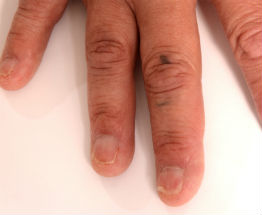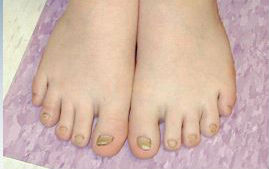Just as there are many different types of ectodermal dysplasias, there are also many different nail abnormalities that can occur in association with these conditions.


The nail is a complex structure formed from the layer of the developing body known as the ectoderm. Nail symptoms for ectodermal dysplasias are fairly common, but not all people who are affected by ectodermal dysplasias will have nail abnormalities.
Along those lines, many of these toenail and fingernail disorders can occur on their own, as part of another condition or otherwise outside of ectodermal dysplasias. If you or a loved one is experiencing one or more of these nail symptoms, get resources on finding a diagnosis.
Find Resources for Diagnosing Ectodermal Dysplasias
Common Nail Symptoms
Nail conditions may include:
- poorly developed nails
- small fingernails and toenails
- thick or thin, brittle nails
- discolored nails
- cracked nails
- abnormally curved nails
- ridged nails
In addition, they may grow slowly or shed periodically. Other times, the nails develop light spots, lines, or patches.
Nails Prone to Infection
Nails with any abnormalities are prone to infection. The nails and surrounding cuticle area may become infected by fungus, yeast or bacteria. If this occurs, nails may become thick or discolored, and the area may develop a bad odor, or become swollen and tender.
To learn more about the root causes and see treatment options for fingernail infections, download our free resource on nail infections.
Nail Abnormalities by Syndrome
See the nail symptoms commonly associated with different types of ectodermal dysplasias.
Ankyloblepharon-ectodermal dysplasia-cleft lip and/or palate syndrome
The nail changes in Ankyloblepharon-ectodermal dysplasia-cleft lip and/or palate (AEC) syndrome are widely variable and include absent or disappearing nails, thinned or thickened nails, irregularly shaped nails and nails with an uneven edge.


Clouston syndrome
The nails for those with Clouston syndrome can be thick and discolored with very slow growth. They can also lift up off the finger.


Learn more about nail abnormalities in Clouston syndrome.
Ectrodactyly-ectodermal dysplasia-clefting syndrome
Ectrodactyly-ectodermal dysplasia-clefting (EEC) syndrome nail abnormalities can include absent nails, thickening of the nails or small pits in the nails.


Focal dermal hypoplasia (Goltz) syndrome
The nail changes in Focal dermal hypoplasia (Goltz) syndrome are quite varied and can include absent nails, ridging and splitting of the nails, along with V-shaped notches at the end of the nails.


Hypohidrotic ectodermal dysplasia

Many people affected by Hypohidrotic ectodermal dysplasia (HED) experience thin nails.
While there are a variety of conditions affecting nails, there are treatment options that you can explore for you or your loved one’s nail abnormalities.
To view this information in a PDF format, download our Nail Abnormalities Info Sheet.